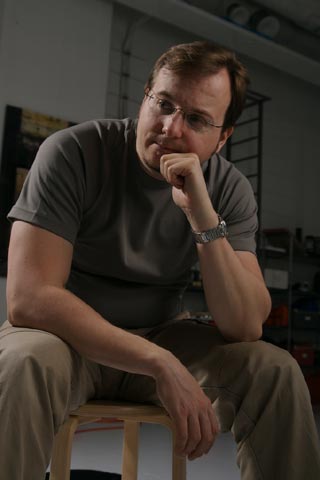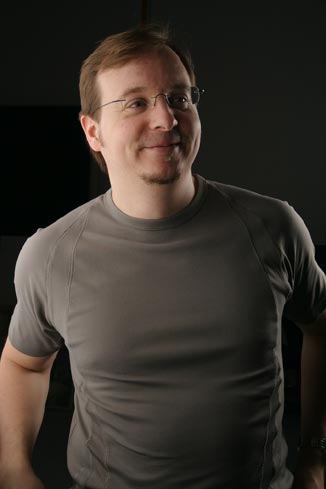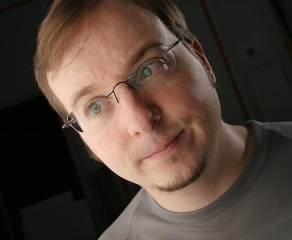Download PDF version: 
He's one of the musicians in the Demoscene who can truly be called "legendary". The soundtrack he wrote for Second Reality by Future Crew together with Purple Motion has reached immortal status. Furthermore, he has contributed to two of the biggest-selling action games to date: Max Payne 1 & 2 by Finnish development studio Remedy, which currently is hard at work on their next big game, Alan Wake. Peter "Skaven" Hajba works at Remedy in various fields. He creates textures, takes care of character animation, particles and sound effects. His skills are not limited to making music for demos, far from it.
After the retirement of Future Crew in 1994, Skaven went into a deep sleep as well, except for occasionally popping up at the Assembly party in Finland, in order to participate in a music competition every now and then. Now, however, Skaven is returning to the scene. He joined Brainstorm. ZINE sat down with the composer and graphics artist to discuss his personal past, present and future.
First musical memories
When Skaven was about five years old, he played around with the piano at his parents' home and enjoyed the sounds it made. "If I remember right, I think I actually tried to play notes and note sequences I enjoyed rather than striking the keys at random," Skaven recalls. "But those are pretty vague early memories, I don't know if there were any major musical realizations back then."
"Would I have gotten sick of the piano lessons?"
I guess I'll never know."
|
His sister, who is 9 years older, was given piano lessons at the time. They proved to be pretty stressful for her and she eventually got tired of them. "I've kept wondering if the same would have happened to me if I had been given piano lessons. Would I have gotten sick of them and stopped doing music altogether, or gotten some early skill bonus? I guess I'll never know."
Right from the start Skaven was obsessed with synthesizers. Back in the '70s, he kept listening to guitars, drums, pianos and other acoustic instruments here and there, but none of them excited him like the otherworldly sounds a synthesizer could make. When he got his hands on a his very first album by French composer Jean-Michel Jarre, there was no holding back. "I wanted to make synthesizer music on my own", remembers Skaven. "Of course, now that everyone and their dog have gone all synth, acoustic instruments have suddenly started to sound really exotic and soulful again."

The Future Crew days will remain in good memory for Skaven
Learning to fly
Skaven's talent wasn't really noticed in his family at first. "I guess neither they nor I realized in which direction I was going to progress. I think the real start for my musical career was when I got my hands on Scream Tracker in 1989. Being able to write songs and save them was a turning point for me. Too bad I completely lacked the equipment for a long time. It wasn't until I was 15 that I got my first synthesizer, a second hand Casio CZ-101, and I had to make do with its limited capabilities. I had no sequencer; nothing. I couldn't sample from the CZ-101, so I had to use samples from other tracker songs."
Skaven never learned to play a specific instrument, lessons-wise. Questioned whether virtuosity with an instrument makes a musician automatically write better songs, he ponders a bit before saying: "I think it actually does. It allows one to experiment and even stumble upon new melodies." Skaven, however, does most of his composing inside his head and in the software. "But sometimes it's about as creative as laying down bricks," he adds with a laugh. "I tend to get wilder ideas when I just sit down and try playing on the keyboard. Nope, I certainly can't claim to be much of a keyboard player, but I occasionally stumble into interesting passages and write them down. The last time that happened was with my Hap Hazard soundtrack. The fourth and last part of the long in-game theme was the result of playing around with my MIDIMan Oxygen8 mini keyboard."

Skaven's workroom
Polishing the creations
It's common knowledge that mixing and mastering is a necessary evil. Skaven fully shares this view. "If your music doesn't play loud and clear, it's going to be ignored no matter how creatively it may be composed. Mixing is a black art. I learn something new every time I get the time to work on some music. Technicality can sometimes become a hindrance. I can get stuck tweaking sounds and parameters when I should be coming up with melodies."
And you never stop learning. Neither does Skaven. "A friend tipped me off on a thing calldd clutter frequencies (something that most studio guys have known for decades, but I only recently became aware of). It may seem that, for instance, a hi-hat sound doesn't contain any bass. But it actually does, and this steals bass bandwidth from instruments that really need the bass. Same goes for treble, but the bass band is the one that gets cluttered most easily if you don't pay attention to it. So the idea is to filter out all frequencies that aren't needed by the instrument. Put a high pass filter in the mixer channel that plays the hi-hats. Remove any bass that the lead synth doesn't need. Don't put too much treble on your bass instrument. Apply a low cut to the reverb effect; reverbs are notorious for qroducing bass clutter."

Skaven has returned to the scene as a member of Brainstorm
"Having become aware of this, I gave my Bejeweled 2 soundtrack another listen, and finally figured out why the mix sounded kind of stuffy. Several instruments in it had lots of these clutter frequencies; for example, the 'angel bell' sample I used mostly for its sparkly treble actually contained loads of really low frequencies. So I took the samples and applied some filtering to them. Suddenly it all sounded much clearer. I haven't released this new version of the soundtrack yet, but I used the new samples in the shortened versions of the music used in the Flash version of Bejeweled 2."
"Being able to write songs and save them
was a turning point for me."
|
When composing a song, it can often happen that you tend to have writer's block. This problem is well known among both writers and composers, and it proves to be a difficult thing when tight deadlines are looming on the horizon. "In such a case, I go for a walk," comments Skaven. "It's surprising how tunes can work themselves out during a walk. Like I said, a major part of a composition happens inside my head. Actually I wish there was some quick and easy way to record tunes that play inside my head; on some mornings I get these cool melodies playing in my head and then they're gone forever."
To date, Skaven didn't have any specific mentors for learning specifics of game soundtrack composition. In fact, he's very pragmatic about it. "I've tried to do it by example of other composers in the industry. None of them have advised me directly, save for a few tips here and there from Purple Motion. On the other hand, I didn't really have to make any true real-time interactive music yet. I guess the closest to that was the Bookworm soundtrack, where the game occasionally switches from 'normal' to 'danger', and the music changes accordingly."
Time is the Remedy
The end of Future Crew also marked the beginning of game development studio Remedy. "I was studying cartoon animation drawing at the Ballyfermot Senior College in Dublin, Ireland. I was going to continue with two years of computer animation studies, when Samuli Syvähuoko, also known as Gore of Future Crew, and currently the founder of Recoil Games, called me and asked if I'd like to work for a game company. I said 'why not?' and returned to Finland. That was some 12 years ago."
Today he's involved with both graphics and audio at Remedy. "I like variety. I'm aware, though, that wearing too many hats spreads one's talents thin. But I still like the variety. In fact, I have made no music whatsoever for Remedy." He ponders for a bit, before adding with a smile: "They hire professionals for that."
Nevertheless, both graphics and audio work have some tedious and boring sides. "Huge amounts of mind-numbingly boring routine work for graphics and game audio - for example, processing 1200 voice-overs - aren't exactly fun. Neither are creative blocks in music. Especially when there's a tight deadline."
Demoscene - nostalgia, challenge and fun
"These days it's always great to see old friends at parties," says Skaven. "I even manage to participate in competitions occasionally, although I have to admit that it has gotten less and less frequent nowadays."

Peter 'Skaven' Hajba
When asked about the ten things that come to his mind when he thinks of the Demoscene, the following points come to his mind:
1. From obscure to mainstream, then back to obscure
2. Source of endless nostalgia and occasional fan mails
3. Latest scene trends overlapping; seriously, one year ago almost every demo featured rotating tori
4. A good thing to do during the dark, wet Scandinavian winters
5. Lack of shower facilities (that was 16 years ago)
6. A good hobby, since it combines different areas of creativity and encourages teamwork
7. Stunning coding innovations
8. A stepping stone into the game industry. At least it was; now they're actually teaching game development in schools
9. Messed up sleep rhythm
10. Spore. When do I get to play it? Will Wright said in his speech that he hired sceners to work on Spore
But in the end, the Demoscene comes down to the greatest moment for every scener including Skaven: Seeing your demo on the big screen and observing the audience's reaction.
Go back to articlelist |

